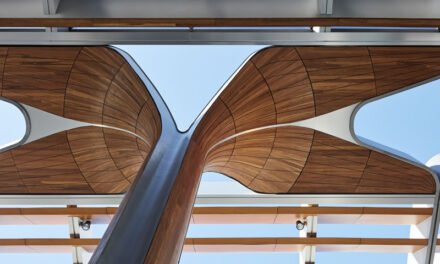Unwanted vibes can have a major effect on homes, so check for the unexpected in designs. By Craig Kay
Poul William Anderson (25/11/1926 – 31/07/2001) was an American science fiction author who wrote from the 1940s until the 21st century. A quote attributed to him is “I have yet to see any problem, however complicated, which, when you looked at it in the right way, did not become still more complicated.”
I have no information on the context of this quote; I do wonder if he was talking about the issue of timber floor vibration and why, every now and then, the end result is not the same as for thousands of virtually identical floor designs.
Annoying floor vibrations are a phenomenon that virtually everyone has experienced at one time or another in a residential building. Vibration is a perceptive quality which varies with source and observer characteristics. What is a problem to one person is seen as ‘normal’ to another?
Hearing glasses clinking in a wall unit because someone has walked across the floor of a room is a classic example of an annoying vibration. A person sitting in a chair may be annoyed by another person’s walking into or out of the room. The vibrations caused by the person’s walking are felt by the person sitting, and attention is drawn away from whatever task is in hand.
Other examples causing excessive vibration are children playing, animals walking or running, and items being accidentally dropped.
The study of human response to vibration essentially began with the Reiher and Meister experiment (1931). In this experiment, a scale of human tolerance defined by peak deflection and frequency was developed in relation to steady-state (continuous) vibration applied for five minutes. The scale included the following divisions:
- Not Perceptible
- Slightly Perceptible
- Distinctly Perceptible
- Strongly Perceptible
- Disturbing
- Very Disturbing
- Injurious
The key factors that influence vibration are mass, stiffness, span length and damping. Generally heavier, stiffer, shorter and highly damped floor systems perform best from a vibration perspective.
The most common source of floor excitation in a domestic residence is footfall, either from walking or aerobic exercise. Footfall can create resident or transient vibration responses.
Vibrations caused by the above activities were not as severe when larger or full-size solid-sawn joists were used in residential floors due to the higher mass and shorter spans typically associated with solid-sawn timber joists. Significant designer experience is also responsible for the lower dynamic severity associated with solid-sawn timber joists.
However, with changes in design and construction techniques, wooden floor systems are spanning greater lengths and are becoming much lighter and more flexible, and for this reason designers need to be more diligent in the consideration of adverse floor vibration issues.
Figuring it out
The strength and serviceability design requirements for floor joists for domestic housing are found in AS1720.3:2016 Timber Structures Part 3: Design criteria for timber-framed residential buildings. The provisions relating to vibration control mirror those found in table C1 of AS/NZ 1170.0, namely the application a 1.0 kN point load at midspan of floor, with the associated deflection not to exceed 2mm. The limit on deflection resulting from the application of the action is intended to ensure satisfactory dynamic performance even though it is not a technically vibration/dynamics type equation.
The Eurocode adopts a more nuanced maximum deflection for the 1.0 kN load that varies dependent upon the span of the joist using the following formula.
Maximum deflection:

It is therefore more conservative than the formula adopted in Australian/New Zealand standards.
This criterion may be insufficient for a more complex floor system, with the table containing two accompanying notes:
- This criterion is given as a guide to whether the floor may have vibrational problems, therefore it is not a definitive yes or no acceptance criteria;
- Floors with a fundamental frequency less than 8 Hz should consider a specific study of the resonant response. The fundamental frequency of floors with steady state loads should be high enough to avoid resonance with the frequency of walking.
Most engineering references that provide calculation methods for determining the natural frequency of the floor only list formulas for single span rectangular floor systems simply supported along all four sides.
Light timber frame flooring has traditionally been supported by load bearing walls or rigid beams such as short span lintels, but with contemporary house designs, joists are often supported upon an array of longer span beams. It is now common for there to be two or more support beams, each with their own elastic properties in the load path between the floor joists and a solid foundation.
Where flexible beams are involved, additional flexibility of the system can lead to systems effects, and present as vibrational problems that you would not find if the floor was supported on loadbearing walls.
A BRANZ document called “Multi-storey light timber-framed buildings in New Zealand – Engineering design,” does provide engineers additional design checks for floors supported by flexible beams.
- The static deflection check under a 1 kN point load of the support beam should be verified for a more stringent deflection of 0.25mm or a maximum limit of 0.5mm if the lower level of vibration performance is acceptable
- The frequency of 8 Hz needs to be verified for the global beam floor system. This frequency can be determined with computer software and a two-dimensional model or alternatively can be approximated using the formula below.

Where: ƒsystem = Natural frequency of the floor system
ƒfloor = Natural frequency of the floor based upon the effective composite bending stiffness
ƒbeam = Natural frequency of the supporting beam/lintel
The end result of an extremely competitive market (in normal market conditions) is that designers/estimators from the respective EWP distributors are understandably tasked with producing a fit-for-purpose floor system at the most competitive cost. In the absence of more rigid serviceability limit specifications, the temptation is therefore for designers to extend floor joists to the maximum recommended limits set by the codes to win work for their company.
Serviceability limits defined by standards are the maximum allowable values, and experience shows that a floor system design that extends the floor joists and supporting beam spans to the code limits, may on occasion present unexpected vibration issues and thus not be fit-for-purpose. Even the change from an assumed direct fix plasterboard ceiling to the lower edge of floor joists to a suspended ceiling, may be the catalyst to tip the result from acceptable to unacceptable floor dynamics.
To retrofit a poorly performing floor is an expensive and time-consuming exercise so floor designers need to examine the architectural plans diligently to determine if there are any design features (e.g. suspended plasterboard ceiling rather than direct fix) that may negatively affect the floor’s dynamic response.
Source: Multi-Storey Light Timber-Framed Buildings in New Zealand – Engineering Design – (David M Carradine et al, 2019).
Craig Kay is the national product engineer for Tilling. For more information on this topic, contact Craig Kay and the Tilling engineers via email at techsupport@tilling.com.au












